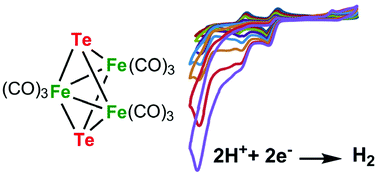Electrocatalytic proton-reduction behaviour of telluride-capped triiron clusters: tuning of overpotentials and stabilization of redox states relative to lighter chalcogenide analogues†
Abstract
Reaction of [Fe3(CO)9(μ3-Te)2] (1) with the corresponding phosphine has been used to prepare the phosphine-substituted tellurium-capped triiron clusters [Fe3(CO)9(μ3-Te)2(PPh3)] (2), [Fe3(CO)8(μ3-Te)2(PPh3)] (3) and [Fe3(CO)7(μ3-Te)2(μ-R2PXPR2)] (X = CH2, R = Ph (4), Cy (5); X = NPri, R = Ph (6)). The directly related cluster [Fe3(CO)7(μ3-CO)(μ3-Te)(μ-dppm)] (7) was isolated from the reaction of [Fe3(CO)10(μ-Ph2PCH2PPh2)] with elemental tellurium. The electrochemistry of these new clusters has been probed by cyclic voltammetry, and selected complexes have been tested as proton reduction catalysts. Each 50-electron dicapped cluster exhibits two reductive processes; the first has good chemical reversibility in all cases but the reversibility of the second is dependent upon the nature of the supporting ligands. For the parent cluster 1 and the diphosphine derivatives 4–5 this second reduction is reversible, but for the PPh3 complex 3 it is irreversible, possibly as a result of CO or phosphine loss. The nature of the reduced products of 1 has been probed by DFT calculations. Upon addition of one electron, an elongation of one of the Fe–Te bonding interactions is found, while the addition of the second electron affords an open-shell triplet which is more stable by 8.8 kcal mol−1 than the closed-shell singlet dianion and has two elongated Fe–Te bonds. The phosphine-substituted clusters also exhibit oxidation chemistry but with poor reversibility in all cases. Since the reduction potentials for the tellurium-capped clusters occur at more positive potentials than for the sulfur and selenium analogues, and the redox processes also show better reversibility than for the S/Se analogues, the tellurium-capped clusters 1 and 3–5 have been examined as proton reduction catalysts. In the presence of p-toluenesulfonic acid (TsOH) or trifluoroacetic acid (TFA), these clusters reduce protons to H2 at both their first and second reduction potentials. Electron uptake at the second reduction potential is far greater than the first, suggesting that the open-shell triplet dianions are efficient catalysts. As expected, the catalytic overpotential increases upon successive phosphine substitution but so does the current response. A mechanistic scheme that takes the roles of the supporting ligands on the preferred route(s) to H2 production and release into account is presented.



 Please wait while we load your content...
Please wait while we load your content...